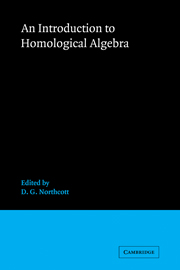Book contents
- Frontmatter
- Contents
- Preface
- 1 Generalities concerning modules
- 2 Tensor products and groups of homomorphisms
- 3 Categories and functors
- 4 Homology functors
- 5 Projective and injective modules
- 6 Derived functors
- 7 Torsion and extension functors
- 8 Some useful identities
- 9 Commutative Noetherian rings of finite global dimension
- 10 Homology and cohomology theories of groups and monoids
- Notes
- References
- Index
8 - Some useful identities
Published online by Cambridge University Press: 08 January 2010
- Frontmatter
- Contents
- Preface
- 1 Generalities concerning modules
- 2 Tensor products and groups of homomorphisms
- 3 Categories and functors
- 4 Homology functors
- 5 Projective and injective modules
- 6 Derived functors
- 7 Torsion and extension functors
- 8 Some useful identities
- 9 Commutative Noetherian rings of finite global dimension
- 10 Homology and cohomology theories of groups and monoids
- Notes
- References
- Index
Summary
Notation. Λ, Γ and Δ denote rings, which need not be commutative, but which possess identity elements. Z denotes the ring of integers.
Bimodules
In Chapter 2 we established enough of the elementary properties of A ⊗ΛG and HomΛ (B, C) to enable us to proceed, for a considerable distance, with the general theory. However, when dealing with special problems, we shall require certain additional results, and it is these which will now be considered. The kind of situation envisaged is that in which we wish to assert that two apparently different constructions with modules lead to the same result. These situations normally arise only when we have to deal with comparatively elaborate operations with modules; and usually, before such an operation can be carried out, one at least of the modules concerned has to have a double structure. For example, in order to be able to form A ⊗Λ(B ⊗ΓC) we require that B ⊗ΓC should be a left Λ-module. If either B or C is a Λ-module, in addition to being a Γ-module, then we can hope to transfer this property to B ⊗γC, but clearly something of this kind is needed.
In this way we come to the consideration of objects which are modules with respect to each of a pair of rings. Roughly speaking, this is what we understand by a bimodule the precise definition being as follows:
Definition. If an additive group M is both a Λ-module and a Γ-module, and if, whenever λ belongs to Λ and γ to Γ, multiplication (of elements of M) by λ commutes with multiplication by γ, then M is said to be a bimodule or, more explicitly, a (Λ, Γ)-module.
Information
- Type
- Chapter
- Information
- An Introduction to Homological Algebra , pp. 155 - 173Publisher: Cambridge University PressPrint publication year: 1960
